| Article ID | Journal | Published Year | Pages | File Type |
|---|---|---|---|---|
| 600954 | Colloids and Surfaces B: Biointerfaces | 2012 | 5 Pages |
Chitosan nanoparticles have been used in several systems destined to controlled release of active agents. In this manuscript the process of formation of chitosan nanoparticles, obtained employing the coacervation method with sodium sulfate is analyzed using zeta potential and small angle X-ray scattering (SAXS) measurements. Dispersions were obtained at pH = 1 and pH = 3 and presented a behavior, in terms of surface charging, that was independent of pH. However, SAXS results indicated a dependence of size-related behavior on pH. The difference in terms of behavior was explained through the influence of enthalpic and entropically driven components.
Graphical abstractFigure optionsDownload full-size imageDownload as PowerPoint slideHighlights► Chitosan nanoparticles obtained using the coacervation method are subjected to enthalpic and entropic influences. ► Enthalpic effect relates to interactions between electrically charged sites and enthalpic effect to spatial arrangement of counter-ions. ► Initially chitosan macromolecular coils shrink, then they collapse, forming clusters of nanometric dimensions. ► If acid concentration is high enough, nanoparticle formation is mainly driven by entropic effects.
